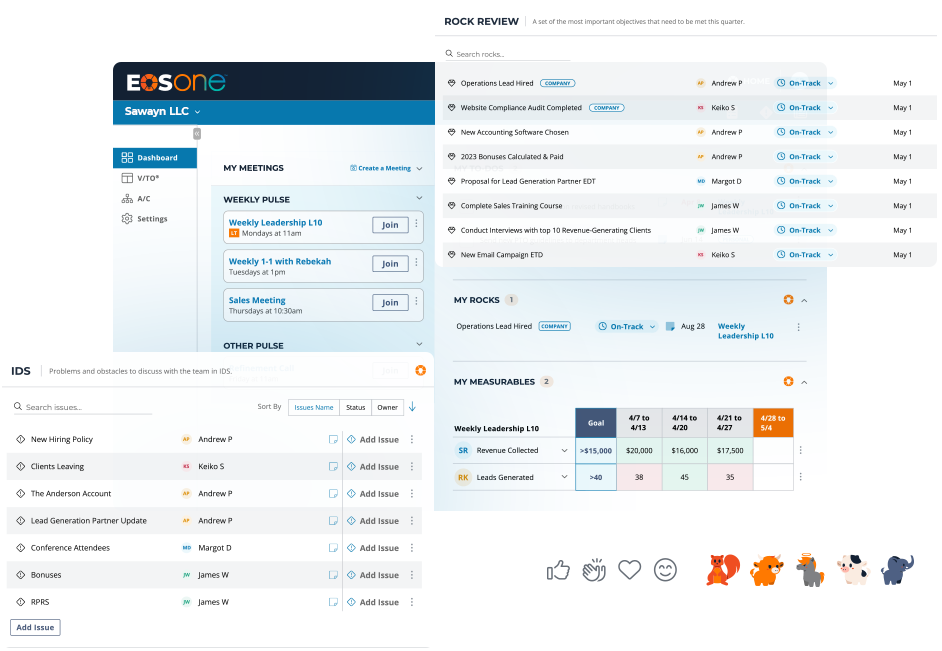Focus has left the room in too many business meetings. Most recurring meetings fail to deliver real value. To run an effective meeting at the leadership, department, or management level, it should drive strategic decision-making, problem-solving, and alignment. Yet, too often, they devolve into unstructured discussions, routine status updates, or—worse—a drain on productivity.
Unproductive meetings don’t just waste time; they create distractions, reduce focus, and leave teams without clear takeaways. More than 90% of professionals admit to multitasking during virtual meetings, a sign that meetings fail to hold attention or produce meaningful outcomes. The result? Teams leave without making decisions or defining the next steps.
When decision-makers, industry experts, or department heads gather, the time should be high-value and outcome-driven—not just an exercise in talking in circles. For business coaches, helping organizations transform their meetings into productive, results-driven sessions can unlock major improvements in execution and efficiency. If standing meetings aren’t producing measurable outcomes or moving the business forward, it’s time to rethink their structure and purpose and run an effective meeting.
Why Most Meetings Fail
Meetings are one of the biggest time investments in any organization—but too often, they don’t produce meaningful results. Studies show executives spend an average of 23 hours per week in meetings, yet 71% say those meetings are unproductive!
Unstructured, unfocused meetings don’t just waste time—they slow down decision-making, drain productivity, and frustrate teams. Here’s why:
- Too Many Status Updates
If a meeting feels like a long-winded checklist of what everyone is working on, it’s not a meeting; it’s a reporting session. Tactical updates should happen asynchronously, not in a meeting designed for problem-solving and decision-making. - Lack of Focus on Solving Real Issues
Meetings should drive action, not just discussion. If your team spends more time talking about problems than actually solving them, your meetings aren’t working. - People Bring the Wrong Issues to the Table
Not every problem is a leadership-level issue. If meetings consistently get sidetracked by operational concerns that could be resolved elsewhere, you’re wasting high-value leadership time on the wrong discussions. - Meetings That Avoid the Hard Topics
The most critical issues that drive growth and profitability are often the hardest to discuss. Your team avoids the actual work if your meetings never include tough conversations about strategy, bottlenecks, or significant business decisions. - Lack of Accountability
Without a straightforward process for turning discussions into action, your meetings become endless loops of the same topics. An effective meeting should always end with clear next steps and accountability for execution.
How to Tell If Your Meetings Are Productive
Effective meetings should drive results, align teams, and remove obstacles—not leave participants wondering why they were there. To assess whether meetings are genuinely effective, ask these three critical questions:
- Are we leveraging the team to move the company forward proactively, or are we stuck in the weeds?
Example: You’re in the weeds if you’re discussing why a project is behind rather than solving what’s fundamentally broken in your process. - Are we solving problems that should be handled elsewhere? Are we taking on someone else’s monkey?
Example: If the leadership team is debating which CRM fields should be required instead of tackling why sales cycles are too long, you’ve taken the wrong monkey. - Are we avoiding the complex and challenging issues we should tackle?
Example: If everyone nods in agreement during your meeting, but thorny issues like market positioning or major bottlenecks never make the discussion list, you’re avoiding the actual work.
Focusing on surface-level topics might seem productive, but it prevents organizations from making the big moves that drive growth. Avoiding challenging issues due to “time constraints” is an excuse—teams make time for what truly matters. If meetings don’t challenge participants, they’re likely not addressing the right priorities.
How to Run an Effective Meeting That Drives Business Growth
High-performing organizations rely on a proven meeting framework to run an effective meeting. One that eliminates wasted time fosters accountability and ensures every meeting produces actual results. Here’s how it works:
- Start with the Right Energy
Break the ice. A simple check-in—like sharing personal and professional good news—creates engagement and sets a positive tone. - Review Key Numbers Fast
Track 5-15 critical business metrics.
No deep dives—just on track or off track.
If something is off track, it becomes an issue to solve later in the meeting. - Align on Priorities
Check-in on key 90-day goals for each leader.
Off track? It becomes an issue to solve. - Keep Updates Brief
Share only essential customer and employee headlines—no unnecessary deep dives.
Quick notes on major wins, challenges, or upcoming key events. - Hold Each Other Accountable
Review last week’s to-dos.
Success = 90% completion rate each week. - Spend the Majority of the Meeting Solving Issues
Identify the most significant business challenges.
Dig into root causes, not just symptoms.
End with an actionable step that fixes the issue for good. - Conclude with Action & Accountability
Recap to-dos and next steps.
Quick check-in: Did this meeting provide value?
Rate the meeting 1-10. Anything below a 10? Improve for next time.
This structured framework ensures that meetings stay focused, action-oriented, and valuable, turning discussions into progress rather than time wasted.
Related LinkedIn Post: I’ve Sat in 2,000 Leadership Meetings
The EOS® Framework: Turning Meetings into a Growth Engine
The structure outlined above is the foundation of the Level 10 (L10) Meeting™, a core part of the Entrepreneurial Operating System (EOS®). This framework has helped over 275,000 businesses improve execution, gain traction, and drive accurate results by keeping leadership teams focused and accountable and solving the most pressing business issues every week.
The reason it works? It follows a disciplined agenda, ensuring meetings don’t drift into unnecessary updates or distractions. Instead, the focus remains on measuring performance, aligning priorities, and resolving key business challenges—the elements that actually move a business forward.
What is a Level 10 Meeting™?
Unlike most meetings, which drift into status updates, an L10 Meeting™ is designed for problem-solving, accountability, and execution. The structured agenda for running an effective meeting includes:
- Segue (5 minutes): Share personal and professional good news to build team cohesion.
- Scorecard Review (5 minutes): Review key metrics to ensure the business is on track.
- Rock Review (5 minutes): Check the status of quarterly priorities.
- Customer/Employee Headlines (5 minutes): Share important client or staff updates.
- To-Do List (5 minutes): Confirm completion of action items from the previous meeting.
- Identify, Discuss, Solve (IDS) Issues (60 minutes): Prioritize and address the most pressing issues.
- Conclude (5 minutes): Recap action items, discuss cascading messages, and rate the meeting.
Related Reading: Level 10 Meeting™
By following this structure week after week, teams gain clarity, stay aligned, and execute with discipline. The L10 Meeting™ isn’t just another meeting—it’s a proven system for turning discussions into action and ensuring businesses achieve real growth.
The Bottom Line: Challenge Yourself and Your Team to Run Effective Meetings
Are your meetings driving real progress, or are they just another checkbox?
Download the L10 Meeting™ Template to start running effective meetings right now!
And if you’re a business coach or consultant, helping clients improve their meetings is one of the most impactful ways to drive better business results. Learn how becoming an EOS Implementer® can equip you with the tools to coach businesses toward better execution and sustained success.





